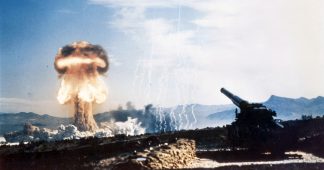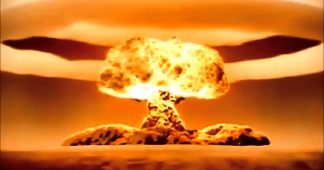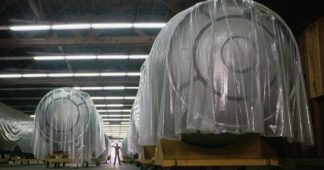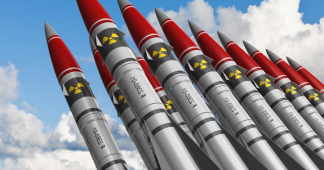By Andrew Facini,
January 28, 2020
In the unintuitive world of nuclear weapons strategy, it’s often difficult to identify which decisions can serve to decrease the risk of a devastating nuclear conflict and which might instead increase it. Such complexity stems from the very foundation of the field: Nuclear weapons are widely seen as bombs built never to be used. Historically, granular—even seemingly mundane—decisions about force structure, research efforts, or communicated strategy have confounded planners, sometimes causing the opposite of the intended effect.
Such is the risk carried by one strategy change that has earned top billing under the Trump administration: the deployment of a new “low-yield” nuclear weapon on US submarines.
Low-yield, high risk. The Trump administration first announced its plans for a new low-yield nuclear warhead in its February 2018 Nuclear Posture Review, a public report meant to communicate and clarify various American nuclear weapons policies. The Nuclear Posture Review presented the lower-strength warhead as necessary for the “preservation of credible deterrence against regional aggression.” In other words, the United States was seeking a new, intermediate option for an imagined scenario in which Russia, after starting a conventional war in Europe, might be tempted to use smaller nuclear weapons first in order to win the conflict. In such a scenario, US thinking goes, the threat of US retaliation with full-strength bombs would not be believable and would not be enough to deter Russia from pursuing such a course in the first place. The way to deter a limited nuclear strike by Russia was for the United States to have a readily available option for retaliating with a limited, proportional strike of its own.
The new weapon proposed in the Nuclear Posture Review is actually a modification of an existing warhead that sits atop the Navy’s submarine-launched ballistic missiles. The W76-2, as the low-yield variant will be called, has an explosive yield of about six kilotons of TNT, compared to approximately 100 kilotons for its unmodified original. The difference in power between the versions is striking, but it’s worth noting that a six-kiloton weapon is still 500 times more powerful than the most powerful conventional explosive in the American arsenal.
But proponents of the low-yield warhead overlook or dismiss a few key concerns that make the W76-2 an unrealistic military option.
First, the imagined target for such a weapon is yet unclear. For most military units and installations, conventional weapons would be a more viable option. For more “strategic” targets like cities or hardened bases, anything but a full-sized nuclear attack would risk failure. What value does a low-yield warhead have if its primary mission is poorly defined? Further, even if an ideal target did present itself, the value and urgency in striking would need to be such that crossing the nuclear barrier would be well worth the precedent it sets.
Second, launching low-yield missiles would create a so-called “discrimination problem.” Since US nuclear submarines will carry both the low-yield and the full-size options, it would be impossible for a potential adversary to determine which kind of warhead a ballistic missile would be carrying until it impacted, leaving no reasonable room to recognize the comparative nuance of a low-yield strike. With a very short window to decide where and how to retaliate, an enemy may just as well assume the worst, and choose a full-sized response.
Third, launching a ballistic missile from a submarine risks revealing that submarine’s location instantly, making it an extremely high value target for a rapid enemy response. Since American ballistic missile submarines are primarily tasked with a “survivable second strike” deterrence role, divulging the whereabouts of any of them at the beginning of a nuclear war would be foolish.
Such tactical circumstances not only invite a huge degree of risk when it comes to mission success, but also provide a likely avenue for rapid enemy escalation—the very opposite of the low-yield warhead’s declared mission. Without confidence and clarity in each of these areas, the use of a low-yield nuclear weapon may in fact produce a much greater amount of destruction, even before the warhead has reached its target.
Finally, critics worry that military planners will be tempted to use the low-yield warhead not for deterrence, but for a first strike. Such concerns were initially dismissed out of hand, but recent news coverage gives them more credibility.
Reporting by Newsweek in January 2020 revealed that in 2016 the United States held a wargame featuring the Air Force’s B61 nuclear bomb—another weapon with a low-yield option—in an imagined battlefield situation against Iran. Despite signing a landmark nonproliferation agreement with Iran the previous year, the Obama administration saw fit to train its command and control systems for a nuclear attack against a non-nuclear state. Officers speaking on the record to Newsweek about the exercise even identified the W76-2 as an imagined first-strike option for such a scenario, suggesting that its deployment is “explicitly intended to make the threat of such an attack more credible.”
These and other techno-strategic concerns have been well covered since the 2018 Nuclear Posture Review, and a wide array of nuclear experts have voiced dissent for the W76-2 program. Nonetheless, by January 2019 the warhead was reportedly in production, and despite early vows to block the program, House Democrats passed a defense budget in December that allocated funds for its continuation. The low-yield option, with all its advantages and problems, will be here for US submarines for the foreseeable future. But the wider landscape of risk goes well beyond the low-yield warhead and highlights a troubling lack of imagination when it comes to modern American nuclear thinking.
An imagination problem. Washington’s decision to add a more “useful” nuclear warhead to its arsenal is, regrettably, just the latest in a string of policies that have served to raise the profile of nuclear weapons around the world. Even before last year’s low-yield announcement, several American initiatives have touched off a series of international responses, each moving the world ever closer to the nuclear brink.
One clear example comes as early as 2002, when the George W. Bush administration pulled out of the 1972 Anti-Ballistic Missile Treaty and established the Missile Defense Agency. In doing so, it signaled, at least from the perspective of its adversaries, a return to a nuclear warfighting approach within the Pentagon: Plans (and capabilities) would move away from the deterrence status quo, and instead allow for more aggressive risk-taking.
Ostensibly meant to counter a North Korea-sized nuclear threat, Washington’s massive investment in missile defense irked planners in Moscow and Beijing, who soon announced their own investment into new missile technologies to overcome missile defense and reestablish their offensive capability.
Those emerging Chinese and Russian missile systems are now being used to justify new American missile projects, with no clarity on the eventual end game. In this, policy makers have imagined the utility of various aggressive weapons systems on a case-by-case basis, with little to no thought given to the long-term consequences of such decisions.
But beyond the well-documented risks of an arms race, the tenor of any given declared policy has an important role in shaping the imagination of the professional strategists tasked with planning for every contingency. When combined with such chalkboard tools as nuclear weapons, an aggressive shift in policy can serve to reinforce itself in time, as military planners draw up new scenarios that make liberal use of available technologies—as exhibited by the 2016 wargame featuring a nuclear first strike.
It’s reasonable to assume the experience with wargames built an internal interest in a low-yield option, a concept that soon came to fruition under an impressionable Trump administration. Without a clear longer-range vision on arms control and the overall role of nuclear weapons, leaders risk feeding into the continual demands of short-sighted technological procurement.
The value of thought. The regrettable reality is that, when it comes to nuclear weapons, clear strategy has always followed capability. The Cold War offers many examples in which a hasty deployment or a misinterpreted exercise resulted in miscalculation and crisis. In recent years, the US government’s handling of nuclear strategy has begun to resemble the most dangerous years of the 1950s, where new technologies were fielded faster than plans and guidance could be properly articulated.
Fortunately, it isn’t too late to curb these trends. The debate over the low-yield warhead and other such proposals matters not just for the sake of crafting responsible policy, but for making sure appropriate intellectual thinking is in place for the many decisions yet to come.
What’s needed most today is not a just technological rebuke of the low-yield nuclear warhead, but a fresh line of thinking about nuclear weapons broadly, and an entirely new set of proscriptive rules for the Pentagon to build around for the coming decades. For that, the field needs new voices, ideas, and perspectives.
Published at https://thebulletin.org/2020/01/the-low-yield-nuclear-warhead-a-dangerous-weapon-based-on-bad-strategic-thinking










